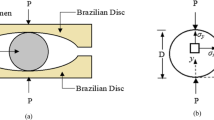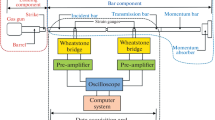Dynamic split tensile tests of reinforced concrete were carried out using the split Hopkinson pressure bar experimental technique to determine the failure modes of reinforced concrete at different strain rates, and the effect of reinforcement ratio and reinforcement layouts on the dynamic performance. The specimens with nine reinforcement ratios were used in the tests. Experimental results show that the tensile strength of reinforced concrete exhibits a critical strain rate, beyond which a larger increase in dynamic strength of specimens occur. The dynamic split tension strength of reinforced concrete is demonstrated to be greater than the plain concrete with the same strength grade over the range of tested strain rates. The results also indicate that the dynamic split tension strength of specimens enhances with the increase in the reinforcement ratio. These findings are instrumental to guide the structural design of reinforced concrete in engineering applications.






Similar content being viewed by others
References
Zh. H. Guo, Theory of Reinforced Concrete Members, Tsinghua University Press, Beijing (1999).
D. A. Abrams, “Effect of rate of application of load on the compressive strength of concrete,” in: Proc. of 20th Ann. Meeting, Vol. 17, ASTM, West Conshohocken, PA (1917), pp. 366–374.
D. Watstein, “Effect of straining rate on the compressive strength and elastic properties of concrete,” ACI J., 49, No. 8, 729–744 (1953).
J. H. Lu, “Influence of reinforcement on the dynamic behavior of concrete,” Trans. Beijing Inst. Technol., 27, No. 6, 473–476 (2007).
C. A. Ross, D. M. Jerome, J. W. Tedesco, and M. L. Hughes, “Moisture and strain rate effects on concrete strength,” ACI Mater. J., 93, No. 3, 293–300 (1996).
C. A. Ross, J. W. Tedesco, and S. T. Kuennen, “Effects of strain rate on concrete strength,” ACI Mater. J., 92, No. 1, 37–47 (1995).
F. Yang, H. W. Ma, L. Jing, et al., “Dynamic compressive and splitting tensile tests on mortar using split Hopkinson pressure bar technique,” Lat. Am. J. Solids Struct., 12, No. 4, 730–746 (2015).
J. H. Yon, N. M. Hawkins, and A. S. Kobayashi, “Strain-rate sensitivity of concrete mechanical properties,” ACI Mater. J., 89, No. 2, 146-153 (1992).
J. W. Tedesco, C. A. Ross, and S. T. Kuennen, “Experimental and numerical analysis of high strain rate splitting tensile test,” ACI Mater. J., 90, No. 2, 162–169 (1993).
D. W. Harris, E. M. Caroline, and P. D. Timothy, “Dynamic properties of mass concrete obtained from dam cores,” ACI Mater. J., 97, No. 2, 290–296 (2000).
L. E. Malvern, D. A. Jenkins, T. X. Tang, and S. A. Ross, “Dynamic compressive testing of concrete,” in: Proc. of 2nd Symp. on the Interaction of Non-Nuclear Munitions with Structures, US Department of Defense, Florida (1985), pp. 194–199.
C. A. Ross, P. Y. Thompson, and J. W. Tedesco, “Split-Hopkinson pressure bar tests on concrete and mortar in tension and compression,” ACI Mater. J., 86, No. 5, 475–481 (1989).
T. H. Antoun, Constitutive/Failure Model for the Static and Dynamic Behaviors of Concrete Incorporating Effects of Damage and Anisotropy, The University of Dayton, Dayton, OH (1991).
R. J. Shang, Investigation of Dynamic Constitutive Behavior of Concrete, Dalian University of Technology, Dalian (1994).
L. J. Malvar and C. A. Ross, “Review of strain rate effects for concrete in tension,” ACI Mater. J., 95, No. 6, 735–739 (1998).
Acknowledgments
The authors wish to acknowledge the financial support provided by the China National Natural Science Funding (Grant No. 11390362) and opening foundation for State Key Laboratory of Explosion Science and Technology (Grant No. 33810005).
Author information
Authors and Affiliations
Corresponding author
Additional information
Translated from Problemy Prochnosti, No. 1, pp. 75 – 81, January – February, 2016.
Rights and permissions
About this article
Cite this article
Zhao, Z., Jing, L., Pei, Q. et al. An Experimental Study of the Dynamic Split Tension Properties of Reinforced Concrete. Strength Mater 48, 63–68 (2016). https://doi.org/10.1007/s11223-016-9738-3
Received:
Published:
Issue Date:
DOI: https://doi.org/10.1007/s11223-016-9738-3




